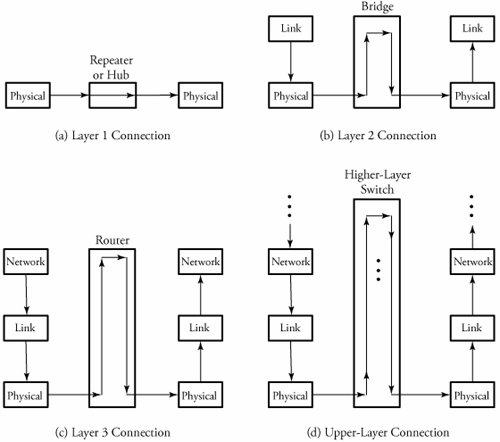Section 3.3. Switching and Routing Devices
3.3. Switching and Routing DevicesSwitching devices are categorized by their complexity, as follows :
Figure 3.9 depicts interconnections and switching functions at layer 1, layer 2, layer 3, and upper layers of the five layer protocol stack. Figure 3.9. Connections in different layers of protocols 3.3.1. Repeaters, Hubs, and BridgesRepeaters and hubs , the simplest switching devices, are designed primarily to interconnect very small LAN units without any involvement in the complex routing processes. Chapter 5 provides several examples of repeaters and hubs. Repeaters are used to connect two segments of a LAN. A repeater's essential function, signal regeneration , differentiates it from a piece of cable. Signal regeneration is needed when the LAN length is extended. When a LAN is extended, bits can be corrupted and decayed. As shown in Figure 3.9, two LANs are interconnected using a repeater at the physical layer (layer 1). The repeater assumes that the connecting LANs have the same protocol and simply accepts bits from one LAN and transmits them on to the other LANs. A hub is another simple device and is used to provide connections among multiple users in layer 1 of a protocol stack. A hub is similar to the repeater but connects several pieces of a LAN. In fact, a hub is a multipoint repeater. To perform this type of connection, a copying element is installed to copy and forward a packet or a frame to all connected users. As a typical repeater, a hub has regeneration capability to strengthen incoming data to prevent any decay. A bridge is a switch that connects two pieces of a LAN or two LANs, especially those operating in layer 2 of the protocol stack. However, a bridge can also be used in layer 1 for signal regeneration. As it operates at layer 2, a bridge does more than simply extend the range of the network. A bridge checks the physical address of any destination user and enhances the efficiency of networks by facilitating simultaneous transmissions within multiple LANs. Unlike repeaters, which transmit a frame to all associated users within a LAN, a bridge does not forward a frame to all LAN users and thus can isolate traffic between two LANs. Bridges can make decisions about where to forward frames . Bridges perform data link functions, such as forwarding, formatting, and error detection. Bridges can forward only one frame at a time in a store-and-forward fashion. However, sophisticated layer 2 switches can forward multiple frames simultaneously through multiple parallel data paths. Layer 2 switches can also operate as cut-through devices, significantly enhancing communication performance. These advantages have made switches more popular than typical bridges. LAN bridges or other intelligent layer 2 switches are devices that use layer 2 data to forward or filter traffic. 3.3.2. Routers and Higher-Layer SwitchesA router is a layer 3 switch that connects other routing nodes, providing a virtual or nonvirtual circuit. A router is dependent on protocols and establishes physical circuits for individual node-pair connection. In packet-switched networks, several pairs of communicating end points can share a circuit virtually, through their own dedicated channels, instead of occupying the entire physical circuit. Bandwidth in a packet-switched network is then dynamically released and shared as needed. A router has a routing look-up table for routing packets. If a communication is connectionless, packets of a message are sent individually but not in order. Owing to the presentation of more sophisticated input and output processors in routers, a router is not concerned about the order of the packets. Layer 3 switches are of two types:
Layer 2 switches are developed to replace routers at a local area network. Typically, the general strategy of the network management is to use the technology of layer 2 switching at layer 3 routing to improve the quality of forwarding packets of routers and to make routers provide sufficient network guarantee. A layer 4 switch uses the information from higher levels for routing decisions. Basically, layer 4 switches are the application switches for both layer 2 and layer 3. In layer 4, packets are normally forwarded on a connectionless system. |
EAN: 2147483647
Pages: 211